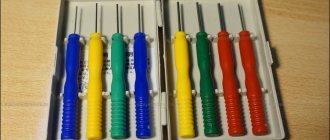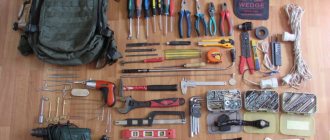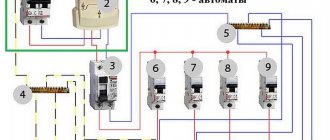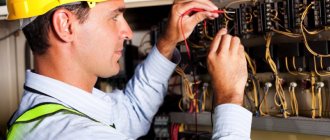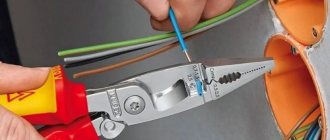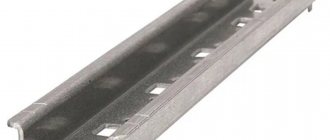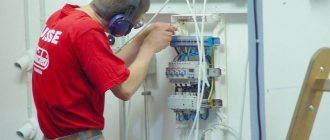To perform electrical installation work in domestic and industrial conditions, the master needs special accessories and devices, ranging from screwdrivers and dielectric gloves to measuring instruments. Thanks to the electrician's tools, you can quickly and efficiently make wiring in the house, repair and connect equipment in the workshop of the enterprise, and troubleshoot transmission lines.
An electrician needs special tools to work.
List of tools
Basic accessories and tools required by an electrician:
- Drill;
- Drills and nozzles;
- Screwdriver;
- Pliers;
- Wire cutters;
- Nylon ties;
- Calipers;
- Indicator screwdrivers;
- Spanners;
- Screwdriver Set;
- Set of crowns;
- Multimeters;
- Latex gloves.
And this is not the entire list of accessories used by electricians.
Requirements for power tools
The main requirement is the serviceability of all components.
Each tool must be:
- No chips or damage. When using a hammer or sledgehammer, the working part should not hang on the handle.
- Of certain sizes - the jaws of the pliers are not sharpened, the cross-section of the chisel is not knocked down, the walls of the wrenches have smooth edges located parallel to each other.
The tool voltage should not exceed 380/220V under normal conditions. If the room is of increased danger, then this indicator is reduced to 36 V.
Power tools are sent for tests once a month to check the integrity of the insulation. Equipment is allowed to be issued only after diagnostics at the stand and standard meter. In addition, the electrician must independently monitor the serviceability of the tool by visual inspection.
The check is carried out before starting any work, as well as before switching on and after moving to the workplace.
Dielectric gloves
When working with elements that are under electrical voltage, use rubber gloves for insulation.
Before you start using gloves, you need to make sure there are no flaws on them.
When purchasing gloves, you need to check them for quality and durability by filling them with air and clamping the hole intended for putting your hand in. If air escapes, then you need to discard them.
Tools for stripping wires
A variety of tools for cleaning insulation makes it possible to perform assigned tasks at a high professional level. Cleaning wires, jewelry work, and in this case you can’t trust knives to beginners.
The wiring has different cross-sections. In this regard, various models have been released for cleaning wires, which differ both in appearance and in purpose.
A regular knife is not so convenient
Having decided on the scope of work, material and preferences, you can choose one of the modifications from the following list:
- Special pliers for stripping insulation. Equipped with holes, blades and jaws. The device is used not only for stripping insulation. They can be used for cable cutting, bending and general gripping.
- Cable knife. It has a rubber handle and a straight sickle-shaped blade made of durable steel. Available for purchase at a price and easy to use, if you have a lot of hands, of course. If the knife is in the hands of a beginner for the first time, then some training will be required in working with it.
- Wire cutters and pliers for stripping insulation. They are a tool for professionals and are used in work where a certain precision is needed.
- Stripper for removing insulation. Used when cutting electrical and optical cables.
Additional Information. When purchasing, you should pay attention to the size to which the device fits. Some models for cleaning wires and cables have a dielectric coating that does not allow electric current to pass through with voltages up to 1000V.
Terminal blocks have earned the greatest popularity in panels
Screwdrivers
Often, an electrician needs different types of screwdrivers for work. They are needed for:
- tightening and loosening contact terminals;
- tightening and unscrewing bolts and screws;
- dismantling broken equipment, etc.
To carry out work, it is better to purchase insulated screwdrivers with long working parts.
Stripping pliers
When considering what tools an electrician uses , you cannot lose sight of special pliers for stripping wires of insulation. They resemble scissors, but between the blades there are a number of holes made for standard thicknesses of electrical wires. When a wire is inserted into the hole and the handles are compressed, the insulation is cut exactly to its thickness—the edge of the blade does not reach the core. It is enough to vigorously pull the pliers towards the outer edge of the wire, and the tube-shaped insulation will slide off the wire and pure metal will remain.
It is recommended to use such a tool both for experienced electricians and for beginners and amateurs. Special knives for removing insulation require working skills, and with the help of pliers, every beginner can remove the insulation on the first try without damaging the core.
Screwdriver
It is used for many jobs. Use this tool to make holes in shields and wire junction boxes.
Instead, you can use a battery-powered screwdriver. The best option would be to purchase it complete with the largest number of attachments, so that the necessary accessories will be at hand at any time.
- Features of choosing building materials for a home
What should you pay attention to when choosing the type of rolled metal for a classic seam roof?
Why do you need to play sports from childhood?
Wall chaser
Nowadays it has become very fashionable and aesthetically pleasing to hide and recess electrical wires into the wall. This requires the presence of grooves and furrows, which are made using a wall chaser. This tool is expensive and is most often used exclusively by professionals working in large or private companies.
Externally, this device resembles a circular saw. It is used to obtain grooves in walls or technical channels in the floor for the purpose of subsequent installation of wiring indoors or outdoors. Using the tool, you can control the depth and width of the groove, and at the same time clean from contaminants formed during work. You can also use another available option, for example, a hammer drill. But this is very labor-intensive and labor-intensive.
The included toolkit contains everything in one case
Note! Today, retail and online stores offer a huge selection of electrician kits. From small to large, which are actively used in everyday life.
The list of the most necessary tools for an electrician has been reviewed. The choice and what is more convenient to use will remain with the contractor. The main thing is not to forget the basic rules regarding self-defense and, of course, follow the basic safety precautions when performing.
Side cutters
In order to cut wires evenly and easily, you need a device such as wire cutters.
Thanks to the special sharpening of the tool's cutters, they cut through the wire without flattening its edges.
Pliers or pliers
Another fairly important hand tool for an electrician is pliers (or pliers). They can be used to tighten small nuts and also cut wires. Pliers must have solid insulated handles. No cuts or cracks are allowed.
In addition to pliers, specific tools such as round nose pliers or duckbill pliers may often be required. Both of these tools are shown in the following photos.
Platypuses differ from round-nose pliers only in the presence of a flat edge, thanks to which in some cases they completely replace pliers. The main purpose of these tools is to shape wire ends and complex bends.
Nylon clamps
To connect several wires into one bundle, ties of various lengths and widths are used. The required clamp size depends on the thickness of the harness.
Do-it-yourself safe wiring in a bathhouse - step-by-step instructionsHow to choose a phase meter - review, purpose, principle of operation, scope of application + instructions for use with photos
How to make a transformer with your own hands - step-by-step instructions, diagram, drawings, list of materials + photo of a finished homemade transformer
Using these clamps you can attach wires to anything.
Nylon zip ties
Nylon ties of various sizes are widely used to connect multiple wires into bundles. They make it easy to secure the wires and make the installation clearer and more aesthetically pleasing.
The cross-section of the wires and their number should be taken into account, after which you can select the appropriate size of the tie. For a small number of wires, a wide tie will not work.
Strippers
These are devices for stripping wires. However, various tools can be used for this:
- knife;
- pliers;
- wire cutters, etc.
But to use such items you need to have experience.
Tinning
To ensure protection of the ends of the wires, tinning is carried out using solder. Soldering irons are used for this. They can be of different powers.
Which hidden wiring detector is better? TOP 10 best manufacturers with photos and descriptions- Technological maps in construction - what is it?
- How to fix a laptop that won't charge
Soldering iron
Such a device is very necessary for working with electricity, however, it is difficult for them to process very thick wires.
For such purposes, a soldering bath is used; it is extremely rare to purchase, as it belongs to the category of professional equipment.
Therefore, they are used only by large organizations and specialists with extensive experience. In the photo you can see what this tool looks like for an electrician.
Accessories and consumables
- They are not mandatory, but greatly facilitate the work.
- These include:
Consumables include insulating tape, which is impossible to do without during electrical installation. It is better to have both PVC and cotton tape. It is often used for other purposes. For example, in order to mark the ends when disconnecting the cable, it is therefore advisable to have a tape of phase colors - red (phase C), yellow (phase A), green (phase B). Ultimately, the set of tools is formed depending on the volume and complexity of the work.
Indicator screwdrivers
Such screwdrivers are used to determine the phase and check the presence of power supply. Any electrician, even a beginner, cannot do without this device.
Its operation is that when a phase is touched, the lamp in the indicator lights up, but when the neutral wire is touched, it does not.
Instrumentation
For any trouble with household appliances or problems with wiring, measurements must be taken. To do this, you must have a multimeter in your kit. To simply determine the presence of a phase, you will need an indicator screwdriver, and to calculate the conductor cross-section you will need a caliper or micrometer. These are all the necessary measuring instruments that should be in an electrician’s kit.
Your power tool bag should contain measuring instruments.
Multimeter or tester
There are two types of electrical measuring instruments for household use - testers and multimeters. In testers, measurement results must be calculated using the appropriate scale and needle deflection, taking into account the divisor/multiplier that is set on the switch at the time of measurements. In general, you need to be careful. That’s why, probably, electricians more often have multimeters that immediately display the result on a digital display, and even with units of measurement.
Multimeters are more popular - they make it easier to take readings
What is important to pay attention to when choosing a multimeter is the accuracy class and measurement limits. The higher the accuracy class, the less error the device has. Thus, multimeters with an accuracy class of 2.5 give an error of 10%. Even if you need to measure the voltage in a 220 V power supply network, plus or minus 22 V is not a little. If we talk about more accurate measurements, such deviations are unacceptable. Therefore, the most widely used multimeters are with an accuracy class of 3.5, which give an error of about 1%. These are already more reliable results, which are enough for a home master. There are devices with class 5 and higher, but their cost is high.
Read how to take measurements with a multimeter here.
Indicator screwdriver
The second necessary tool is an indicator screwdriver. This is a small device that costs very little, but is very convenient to use. The presence of phase voltage on the conductor is checked by simply touching the tip of a screwdriver to a bare conductor, a current-carrying part, or to a socket. The LED built into the handle lights up.
An indicator screwdriver should be in the electrician's kit
This is really a very necessary thing for an electrician, with which you can instantly test the presence of dangerous phase voltage before starting work.
Caliper or micrometer
Oddly enough, but a home electrician should also have this tool. It will come in handy when purchasing a cable or wire. The thing is that the actual cross-section of the conductors may differ significantly from the parameters declared by the manufacturer. And since the load with which it can work depends on the cross-section of the wire, such a difference can be critical and lead to wiring failure and even a fire.
A caliper or micrometer is needed to determine the actual wire cross-section
Therefore, before purchasing any cable or wiring, it is worth measuring the diameter of the wire and determining its cross-section. And using this data, make a decision about whether to purchase this product. Read about how to determine the cable cross-section by diameter here.
TIN-1
In order to determine low voltage in the electrical network, this device is used.
It has two probes connected by a wire; one of the probes is equipped with a warning light.
Low voltage indication
In the modern world, there are devices designed to discharge the battery (or indicate low voltage). This model is widely used in various fields of science and technology. It is used to make a device that controls the battery charge.
You may be interested in: Features for choosing a soldering iron
In order to determine the low voltage indication, devices called INN-1, consisting of two probes, are used. One of them has a lamp that gives a signal. If the probe touches the wire, the light comes on. They have a durable body and good insulation.
There is a 3 in 1 option
Multimeter
This measuring device is considered the most reliable for determining voltage.
Currently, there are digital versions of these instruments that measure:
- resistance;
- voltage;
- current strength.
For electricians with little experience, an inexpensive model will be enough, but for professionals it is better to have a model with wide functionality.
Electric drill
It can be said to be a universal tool for an electrician. When working with it, you may need various attachments and drills.
It is advisable that it be equipped with a hammer drill; this is necessary for drilling holes in concrete walls for branch boxes, sockets, and switches.
It would take a long time to list the electrician's accessories, but the main ones are those described above.
Spanners
Wrenches are the main tool not only for plumbers, but also for electricians. An electrician often uses such tools at the installation stage.
The electrician also has to turn the nuts.
Types of keys:
- Bolognese;
- gates;
- dynamometer;
- intrinsically safe;
- keys for grinder;
- splined;
- keys for electrical cabinets;
- split;
- universal keys;
- combined;
- open-end wrenches;
- adjustable.
Among the huge variety, it can take a long time to choose, and there is not much point. An electrician, just like a plumber, can use a regular and universal adjustable wrench instead of a huge set of wrenches. Outwardly, it looks like a regular tool, but at the same time it has a sliding jaw, thanks to which you can adapt to any size of nuts. The handle of the adjustable wrench may have a special dielectric coating.
For your information. This wrench is suitable for working with live electrical devices.
Often it is necessary to determine the presence of voltage in the network
Photo of electrician's tools
Did you like the article? Share
0
